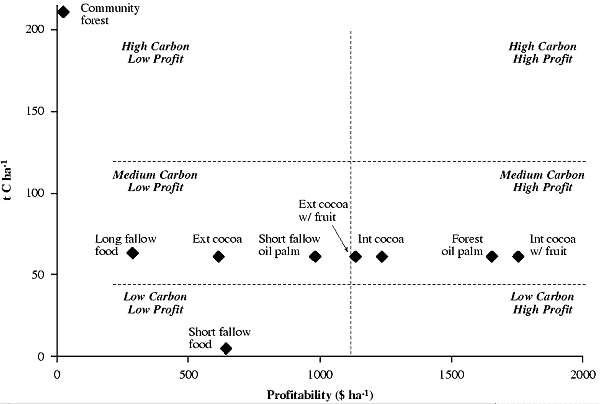
Agroforestry is a management system that integrates trees on farms and in the
agricultural landscape. It leads to a more diversified and sustainable production
system than many treeless alternatives and provides increased social, economic,
and environmental benefits for land users at all levels (Sanchez, 1995; Leakey,
1996; Fay et al., 1998). Agroforestry is practiced from the Arctic to
the south temperate regions, but it is most extensive in the tropics. Approximately
1.2 billion people (20 percent of the world's population) depend directly on
agroforestry products and services in rural and urban areas of developing countries
(Leakey and Sanchez, 1997). Agroforestry encompass a wide variety of practices,
including crop-fallow rotations, complex agroforests, simple agroforests, silvopastoral
systems, and urban agroforestry (Steppler and Nair, 1987; Fujisaka et al.,
1996; Huxley, 1999).
Agroforestry practices in the temperate regions include planting trees at wide
spacing in combination with pastures or crops; this practice results in increasing
carbon density in Annex I countries (Buck et al., 1999). Examples in
Canada include the Permanent Cover Program under the Prairie Farm Rehabilitation
Administration. Agroforestry in North America was reviewed by Lassoie and Buck
(1999).
Agroforestry systems can be superior to other land uses at the global, regional, watershed, and farm scales because they optimize tradeoffs between increased food production, poverty alleviation, and environmental conservation (Izac and Sanchez, 2000). They can also be inferior to other land uses, particularly when the technology is inappropriate or the accompanying policies are not enabling (Sanchez, 1995). Analysis of tradeoffs between private farmer benefits and global environmental benefits provide a solid basis for partitioning benefits arising from global environmental conventions and protocols. Figure 4-9 illustrates tradeoffs between carbon sequestration and farmer profitability in Cameroon in a range of agroforestry practices.

|
| Figure 4-9: Tradeoffs between carbon stocks and social profitability of land-use systems in Cameroon (Gokowski et al., 1999). |
(continues on next page)
|
Other reports in this collection |